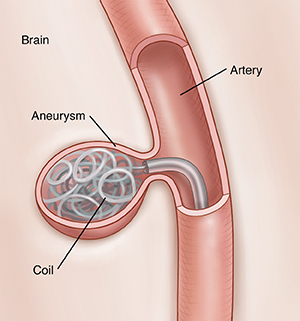Embolization for Brain Aneurysm
Embolization is a procedure used to treat a brain aneurysm. This is a bulge in the wall of a brain artery. If the aneurysm bursts (ruptures) and bleeds, nearby brain tissue may be damaged. This can cause a deadly stroke. This procedure may be done before an aneurysm bursts. It can help prevent these problems. It can also be done after an aneurysm has burst. The procedure is done by putting something inside the aneurysm. This may be metal coils, liquid, or special particles. This helps seal the aneurysm. It stops it from bleeding or rupturing.
Getting ready for your procedure
Embolization may be done as an emergency procedure after an aneurysm has burst. You or a family member should tell your healthcare provider if you:
Also tell your provider about any medicines you are taking. You may need to stop taking all or some of these before the procedure. This includes:
-
All prescription medicines
-
Over-the-counter medicines, such as aspirin or ibuprofen
-
Street drugs
-
Herbs, vitamins, and other supplements
Follow all directions you’re given for not eating or drinking before the procedure.
Follow all other directions your healthcare team gives you to get ready.
During your procedure
The procedure usually takes about 1 to 2 hours. In general, you can expect the following:
-
You will be given medicine (anesthesia). This is to stop you from feeling pain during the procedure. You may be given general anesthesia. This puts you into a state like a deep sleep. Or you may be given sedation with local anesthesia. Sedation makes you relaxed and sleepy. Local anesthesia numbs the areas to be worked on.
-
The procedure is done with a long, thin tube (catheter). The healthcare provider makes a small cut (incision) at the site where the catheter will be inserted. This is most often an artery in the groin. The catheter is moved through the artery all the way up to the brain.
-
The provider sends dye through the catheter. The dye makes it easier to see the artery and catheter on X-ray images. The catheter's movement can be seen on a video screen.
-
The provider uses the catheter to place metal coils, liquid, or special particles into the aneurysm. This causes a blood clot to form that seals the aneurysm and prevents bleeding.
-
Then the catheter is removed. The incision in the groin is closed and bandaged.
 |
| Metal coils may be used to treat an aneurysm. |
After your procedure
You’ll need to lie still for 4 to 6 hours after the procedure. Pressure may be applied to the site in your groin. This is to help reduce the risk of bleeding. Once you're stable, you’ll be moved to a hospital room. You may need to stay in the hospital overnight if the aneurysm was not yet ruptured. If it did rupture and cause a stroke, you will stay in the hospital until you recover. This may be for 1 to 4 weeks. It depends on how much harm the aneurysm caused to your brain. While you’re in the hospital, you will have more imaging tests. They will show the coils, particles, or liquid in the aneurysm. The tests also help check that there is no more bleeding.
Risks and possible complications
All procedures have some risk. Risks of this procedure include:
-
Bruising, bleeding, or infection at the catheter insertion site
-
Swelling or bleeding in the brain
-
Problems from the X-ray dye, including allergic reaction or kidney damage
-
Blood clots
-
Damage to an artery
-
Seizures
-
Death
-
Stroke
If you had a stroke, you may also have short-term or long-term nervous system problems. These may include:
You may also need more treatment or surgery. This may be the case if treatment is not complete, or an aneurysm occurs again.
Online Medical Reviewer:
Anne Fetterman RN BSN
Online Medical Reviewer:
Deepak Sudheendra MD
Online Medical Reviewer:
Raymond Kent Turley BSN MSN RN
Date Last Reviewed:
9/1/2022
© 2000-2025 The StayWell Company, LLC. All rights reserved. This information is not intended as a substitute for professional medical care. Always follow your healthcare professional's instructions.